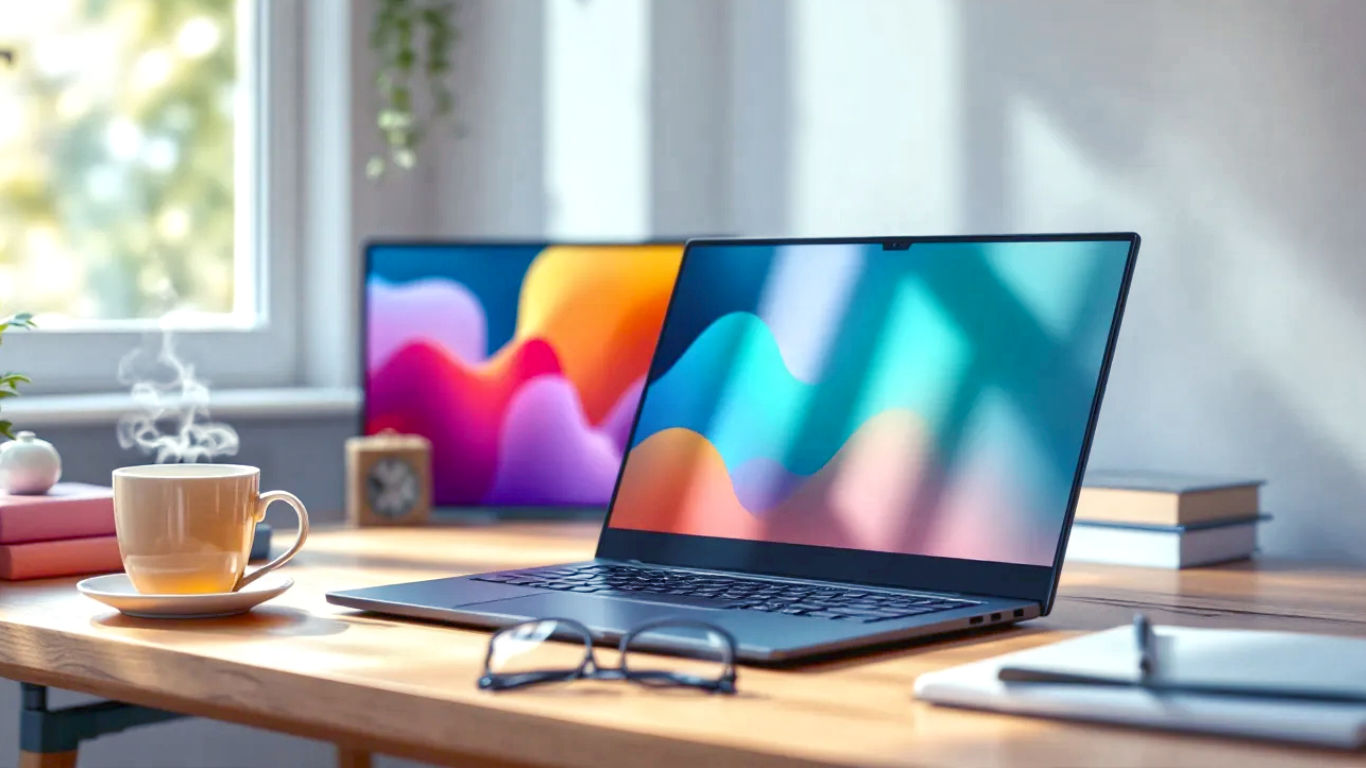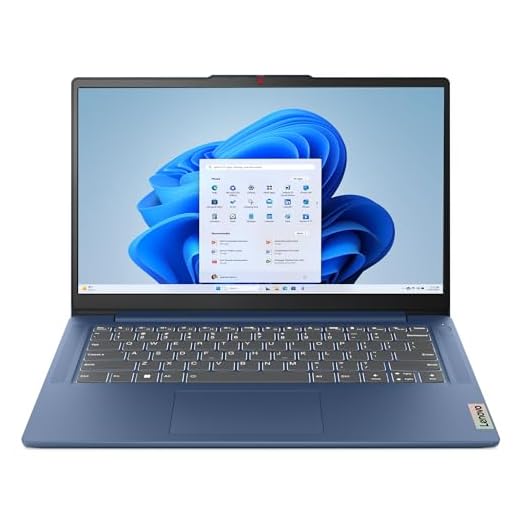The Guide to the Lenovo IdeaPad Slim 3 (16-Inch): Is It Worth Your Money?
A deep-dive review of the 16-inch Lenovo IdeaPad Slim 3 for the UK market. We analyse its performance, design, and value for students and home users.

This post may contain affiliate links. If you make a purchase through these links, we may earn a commission at no additional cost to you.
Finding a decent laptop that doesn’t cost a fortune can feel like trying to find a sunny spot on a British beach in December. You know they exist, but they’re few and far between. Enter the Lenovo IdeaPad Slim 3 16-inch. It’s a machine that promises a big screen and solid performance without making your wallet weep. But is it all talk and no trousers?
We’re going to dive deep into this laptop. Think of this as your complete guide, the sort of thing you’d chat about with a tech-savvy mate down the pub. We’ll look at what it’s good for, where it falls short, and whether it’s the right choice for you, whether you’re a student in Manchester, a remote worker in Bristol, or just someone who fancies a bigger screen for watching Netflix in bed.
This isn’t just about numbers and tech jargon. We’ll translate what the specs actually mean for everyday use—from writing essays and crunching spreadsheets to streaming The Great British Bake Off. By the end of this, you’ll know if the IdeaPad Slim 3 is the trusty workhorse you’ve been looking for or if you should keep searching.
What Exactly is the Lenovo IdeaPad Slim 3?
Before we get into the nitty-gritty, let’s get our bearings. What sort of machine are we actually talking about here?
The Lenovo IdeaPad range is all about providing everyday laptops for everyday people. They’re not designed for hardcore gamers or professional video editors who need a supercomputer in their backpack. Instead, they’re aimed at the vast majority of us: students, families, and professionals who need a reliable machine for day-to-day tasks.
The ‘Slim’ part of the name tells you it’s designed to be reasonably portable. While the 16-inch model is hardly tiny, Lenovo has made an effort to keep it from being a massive, clunky beast. The goal is a comfortable balance between a large, easy-to-read screen and a laptop you can still pop in a bag without giving yourself a backache.
This specific model, the 16-inch version, is all about that bigger display. It’s for people who find smaller laptop screens a bit cramped. If you spend your days staring at spreadsheets, writing long documents, or just enjoy having more space for your apps, that larger screen is the main attraction.
Lenovo IdeaPad Slim 3 | 14 inch Full HD Laptop | Intel Core i5-12450H| 16GB RAM | 512GB SSD |Windows 11 Home | Abyss…
-
Available in Abyss Blue, this thin and light laptop weighs just 1.37 kg and is 17.9 mm thin, designed for on-the-go use.
-
Features a 14-inch Full HD display with 4-sided narrow bezels and an 88% Active Area Ratio for crisp, vivid visuals.
-
Equipped with Dolby Audio for an enhanced sound experience.
-
Includes a full-function USB Type-C port for power delivery, display output, and data transfer.
-
Offers Rapid Charge Boost, providing two hours of battery life from just a 15-minute charge.
-
Enhanced security and privacy with a 2-in-1 fingerprint sensor and an FHD camera featuring a physical privacy shutter.
-
TÜV certified for low blue light to help protect your eyes during long sessions.
-
Connectivity options include Wi-Fi 5, Bluetooth, 2x USB 3.2 Gen 1 ports, 1x HDMI 1.4, and a card reader.
Who is this Laptop For (and Who Should Avoid It)?
Let’s be clear about the target audience here.
This laptop is a great fit for:
- Students: The big screen is brilliant for research, writing essays, and online lectures. It’s affordable, which is a huge plus when you’re living on a student budget.
- Home Office Workers: If your job involves emails, Microsoft Office, video calls, and browsing the web, the IdeaPad Slim 3 has more than enough power to keep you productive.
- Families: It’s a solid choice for a shared family computer. It can handle homework, online shopping, banking, and streaming shows for a movie night.
- Casual Users: For anyone who just wants a straightforward, reliable laptop for browsing, social media, and watching videos, this is a strong contender.
You might want to look elsewhere if you are:
- A Serious Gamer: The basic model with its standard Intel graphics just won’t cut it for the latest blockbuster games like Cyberpunk 2077 or Baldur’s Gate 3. You’ll need a dedicated gaming laptop for that.
- A Creative Professional: If you’re a video editor, graphic designer, or music producer, you’ll need more power, more RAM, and a much better screen. Look at lines like the MacBook Pro or Dell’s XPS range.
- A frequent traveller: While it’s called ‘Slim’, a 16-inch laptop is still a hefty bit of kit. If you’re always on the move, a smaller 13 or 14-inch ultrabook would be a much more practical choice.
Think of it as a dependable Ford Focus, not a flashy Ferrari. It’s built to do a job, do it well, and not cause any drama.
Design and Build: First Impressions
When you first unbox the IdeaPad Slim 3, the first thing you’ll notice is its sheer size. A 16-inch screen makes for a large laptop, but Lenovo has done a good job of keeping the bezels (the plastic borders around the screen) reasonably thin. This gives it a more modern look and stops it from feeling like a relic from 2010.
Look and Feel
The model we’re focusing on comes in an ‘Abyss Blue’ colour, which is a fancy way of saying dark, slightly metallic blue. It’s smart and professional, and it won’t look out of place in an office or a university library. The chassis is made of plastic, which is expected at this price point. Don’t expect the cold, premium feel of an aluminium MacBook.
That said, it doesn’t feel cheap or flimsy. Lenovo says it’s ‘military-grade rugged,’ which is a bit of marketing fluff, but it does mean it’s been tested to withstand a few bumps and knocks. It should survive being carted around in a backpack without any trouble. There’s a bit of flex in the keyboard deck if you press down hard, and the lid has some wobble, but it’s nothing to worry about in normal use.
It weighs around 1.74 kg (about 3.8 lbs) and is 18.4 mm thick. For a 16-inch machine, that’s actually quite respectable. It’s about 10% slimmer than the previous generation. You will definitely notice it in your bag, but it’s not so heavy that it becomes a burden for the occasional trip out.
The Keyboard and Touchpad
Lenovo has a reputation for making excellent keyboards, and thankfully, the IdeaPad Slim 3 doesn’t disappoint. The keys are well-spaced, have a decent amount of travel (how far they press down), and offer a satisfying, slightly clicky feel. It’s comfortable to type on for long periods, which is a massive plus for students and writers.
Because it’s a larger laptop, you also get a full-sized number pad on the right-hand side. This is a godsend if you work with spreadsheets or numbers a lot. It’s a feature you rarely find on smaller laptops, and it’s a genuine selling point here.
The touchpad is large and responsive. It uses Windows Precision drivers, which means gestures like pinching to zoom and swiping with three fingers to switch apps work smoothly. The clicking mechanism is integrated into the pad itself. It works fine, but some people might prefer separate left and right-click buttons.
The Screen: Big, but is it Beautiful?
The display is the star of the show here. It’s a 16-inch WUXGA IPS panel. Let’s break down what that actually means.
- 16-inch: This is the diagonal measurement of the screen. It gives you loads of space to work with, making it easy to have two windows open side-by-side.
- WUXGA: This stands for Widescreen Ultra Extended Graphics Array. It’s a fancy name for a resolution of 1920 x 1200 pixels. This is slightly taller than the standard Full HD (1920 x 1080) you find on most laptops. That extra vertical space is brilliant for reading websites and documents, as you have to do less scrolling.
- IPS: This stands for In-Plane Switching. It’s a type of screen technology that gives you much better viewing angles and more accurate colours than older, cheaper TN panels. It means you can look at the screen from the side without the colours looking washed out.
How Does it Look in Practice?
In the real world, the screen is a mixed bag, and this is where the laptop’s budget price starts to show.
For everyday tasks like writing, browsing the web, and watching YouTube, it’s perfectly fine. Text is sharp, and the extra height from the 16:10 aspect ratio is genuinely useful.
However, the screen’s brightness and colour accuracy are not its strong points. It’s not a particularly bright display, which means it can be hard to see clearly if you’re in a brightly lit room or, heaven forbid, trying to work outside on a sunny day. The colours can also look a bit muted and washed out compared to more expensive laptops.
If you’re a photographer or designer who needs perfect colour accuracy, this screen is not for you. But for watching Netflix or showing a presentation, it’s perfectly acceptable. It’s a classic case of ‘good enough for the price’.
Performance: The Engine Under the Hood
Okay, let’s talk about what makes this thing tick. The specific model we’re looking at from Amazon.co.uk comes with a very basic set of components. It’s crucial to understand what these parts do and what they mean for performance.
- Processor: Intel Processor U300
- RAM (Memory): 4GB
- Storage: 128GB SSD
- Operating System: Windows 11 Home in S mode
Let’s tackle these one by one.
The Processor: Intel U300
The processor, or CPU, is the brain of the laptop. The Intel U300 is a modern but distinctly entry-level chip. It’s designed for efficiency and low power consumption, which is good for battery life, but it’s not a powerhouse.
It can handle one or two tasks at a time perfectly well. You can write a document in Word, browse a few tabs in Chrome, and have your emails open in the background without any issues. But if you start pushing it—say, by opening 20 Chrome tabs, trying to edit a photo in Photoshop, and listening to Spotify all at once—you will notice it start to slow down.
It’s a processor built for basic productivity and media consumption, and for those tasks, it’s competent.
The RAM: 4GB is Not a Lot
RAM, or Random Access Memory, is your laptop’s short-term memory. It’s where it keeps the data for the apps and files you’re currently using. The more RAM you have, the more things you can do at once without the computer getting sluggish.
And here we hit the biggest weakness of this particular model: 4GB of RAM.
In 2025, 4GB is the bare minimum to run Windows 11. It’s enough to get by, but it’s a significant bottleneck. Modern web browsers like Chrome are notoriously hungry for RAM. With only 4GB, you’ll find that having more than a handful of tabs open will cause the system to slow down as it struggles to keep up.
If you are a light user who only ever does one thing at a time, you might be okay. But for most people, this is going to be a source of frustration. If you can find a version of the IdeaPad Slim 3 with 8GB of RAM, it is strongly, strongly recommended you pay the extra for it. It will make a night-and-day difference to the user experience.
The Storage: Fast but Small
Storage is where your files, photos, and applications are kept permanently. This model comes with a 128GB SSD.
The good news is that it’s an SSD (Solid State Drive), not an old-fashioned hard drive. SSDs are incredibly fast. They allow the laptop to boot up in seconds and make opening apps feel snappy and responsive. This is a huge quality-of-life improvement.
The bad news is that 128GB is not a lot of space. Windows 11 itself will take up a good chunk of that. After you’ve installed Microsoft Office and a few essential apps, you won’t have much room left for personal files, photos, or music.
You will almost certainly need to rely on cloud storage like Google Drive or OneDrive, or invest in an external hard drive to store your files. Again, if you can find a model with a 256GB or 512GB SSD, it’s worth the upgrade.
Windows 11 in S Mode: The Walled Garden
This laptop comes with Windows 11 Home in S mode. This is a special version of Windows that’s designed to be more secure and perform better on lower-end hardware.
The catch? You can only install apps from the official Microsoft Store. You can’t just go to a website and download an application like Google Chrome, Steam, or Adobe Photoshop.
This might be fine for some people. The Microsoft Store has a lot of popular apps, including Netflix, Spotify, and the full Microsoft Office suite. And it does make the laptop safer from viruses.
However, for most people, this is too restrictive. The good news is that switching out of S mode is free and easy. It only takes a few clicks in the settings menu. It’s a one-way street, though—once you switch out, you can’t go back. Most users will want to do this almost immediately to get access to the full range of Windows software.
Everyday Use: Living with the IdeaPad
So, what’s it like to use this laptop day in, day out?
For general web browsing, writing emails, and using Microsoft Office, it’s a pleasant experience. The keyboard is comfortable, the large screen is easy on the eyes, and the SSD keeps things feeling responsive, despite the limited RAM.
Video calls are handled well. The laptop has a built-in webcam with a physical privacy shutter. This is a fantastic feature. It’s a little sliding cover that blocks the camera, giving you complete peace of mind that no one is watching when you don’t want them to. In an age of endless Zoom and Teams meetings, that’s a brilliant touch. The webcam itself is a standard 720p affair—it’s not going to win any awards for image quality, but it’s perfectly adequate for calls with colleagues or family.
When it comes to entertainment, the experience is a bit more varied. The big screen is great for watching films and TV shows on services like BBC iPlayer or Netflix. However, the speakers are pretty dreadful. They’re tinny, lack any bass, and are located on the bottom of the laptop, so the sound is muffled. You will absolutely want to use headphones or external speakers for any kind of audio.
Battery Life and Connectivity
A laptop isn’t much good if it has to be plugged in all the time. Lenovo claims the IdeaPad Slim 3 has a large battery that will see you through the day.
In reality, you can expect around 6 to 8 hours of mixed use from a full charge. That means a day of light web browsing, word processing, and maybe a bit of video streaming. If you start doing more intensive tasks or crank the screen brightness up, that number will drop. It’s not the best battery life on the market, but it’s enough to get you through a day of lectures or work away from your desk without panicking about finding a plug socket.
One of the best features is Rapid Charge Boost. This allows you to get about two hours of extra battery life from just a 15-minute charge. This is incredibly useful if you’re about to head out and realise your battery is nearly dead.
Ports: Everything You Need
For a ‘slim’ laptop, the IdeaPad Slim 3 has an excellent selection of ports. This is a real advantage over many modern ultrabooks that force you to live with a collection of dongles and adapters.
On this machine, you get:
- Two standard USB 3.2 ports: For connecting things like a mouse, keyboard, or external hard drive.
- One USB-C port: This is a modern, versatile port. It supports data transfer, charging the laptop itself (Power Delivery), and connecting to an external monitor (DisplayPort). This is a fantastic inclusion at this price.
- An HDMI port: For easily connecting to a TV or projector.
- A 3.5mm headphone/microphone jack.
- An SD card reader: Great for getting photos off a digital camera.
This is a really practical and generous selection. You can plug in all your essential accessories without needing to carry around a bag full of adapters, which makes it a very convenient machine for business or presentations.
The Verdict: A Great Budget Laptop with One Big Catch
So, after all that, is the Lenovo IdeaPad Slim 3 16-inch a good buy?
The answer is a qualified yes.
It gets a lot of things right. The big, tall screen is great for productivity. The keyboard is a genuine pleasure to type on. The selection of ports is fantastic, and the inclusion of a webcam privacy shutter is a thoughtful touch. For a large-screen laptop, it’s reasonably slim and light.
It offers a solid foundation for a dependable, no-frills workhorse. It looks smart, feels sturdy enough for daily use, and handles basic tasks with ease.
However, the specific model sold on Amazon with 4GB of RAM and a 128GB SSD is hamstrung by its own specifications. The 4GB of RAM is a serious bottleneck that will impact your ability to multitask effectively. The 128GB of storage will fill up incredibly quickly.
Our Recommendation:
The Lenovo IdeaPad Slim 3 16-inch is an excellent budget laptop, but not this specific version.
You should treat this model as the absolute entry point. If your budget is incredibly tight and your needs are very basic, it will just about do the job.
But for a much better experience that will last you longer, you should look for a configuration with at least 8GB of RAM and a 256GB SSD. These versions are often available for not much more money, and the performance improvement will be huge. The extra investment will transform the laptop from something that just about gets by into a genuinely capable and enjoyable machine to use.
Think of it like buying a car. This model is the basic version with a tiny engine and manual windows. It will get you from A to B, but for a little bit extra, you can get the one with the better engine and air conditioning, which will make every journey far more pleasant. The chassis is great; it just needs a slightly better engine inside.
Further Reading & Resources
For those who wish to delve deeper, here are some highly respected resources for laptop reviews and tech analysis:
- Expert Reviews: A trusted UK-based source for impartial, in-depth reviews of technology products, including laptops. https://www.expertreviews.co.uk/laptops
- TechRadar: A globally recognised site with a dedicated UK team, offering comprehensive reviews, buying guides, and tech news. https://www.techradar.com/uk/news/computing/laptops
- PC Pro: A long-standing authority in the UK tech scene, known for its rigorous, lab-based testing and professional analysis. https://www.pcpro.co.uk/laptops
- Lenovo’s Official UK Product Page: For direct specifications, model comparisons, and purchasing options. https://www.lenovo.com/gb/en/laptops/ideapad/







